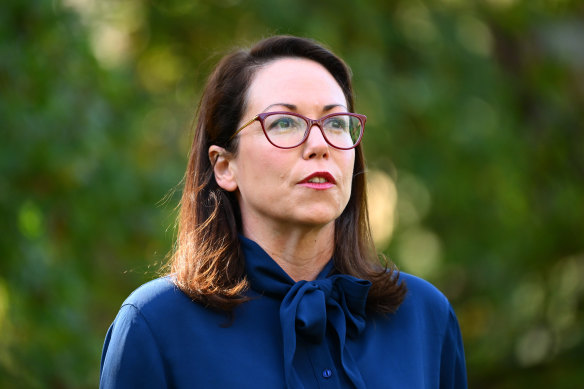Crime rate climbs with age: Difficult debate looms on changing rules for child offenders

Save articles for later
Add articles to your saved list and come back to them any time.
Crime data shows 13-year-olds are charged with four times more aggravated burglaries, five times more car thefts and four times more aggravated robberies than 12-year-olds, highlighting the task facing the Andrews government as it debates what offences will be exempted when the age of criminal responsibility lifts.
Children aged 10 and 11 will not be held criminally culpable for their actions by the end of next year, but Attorney-General Jaclyn Symes said there would be “appropriate exceptions” for children who have committed certain serious offences ahead of the full-scale reform to lift the age of criminal responsibility to 14 by 2027.
Attorney-General Jaclyn Symes will need to decide which offences are not included when the age of criminal responsibility is lifted to 14. Credit: AAP
While there are expected to be carve-outs for grave offences, including murder and terrorism, so 12- and 13-year-old children could still face prosecution for those crimes, there will need to be debate about whether the government extends that to mid-tier offences, such as aggravated burglaries, robberies and serious assaults.
Crime statistics obtained by The Age show a discernible increase in the number of children being prosecuted for aggravated burglary and robbery, motor vehicle theft and serious assault when their age climbs from 12 to 14.
In the five years to 2022, there were 15 offences of 10-year-old children charged with serious assault, compared with 250 alleged offences recorded by 12-year-olds, 700 by those aged 13 and 1100 by 14-year-olds. There were no aggravated burglary or robbery offences recorded in the 10-year-old age group, but those figures jumped to 80 and 30, respectively, among 12-year-olds, rising to 370 and 130 by 13-year-olds.
The biggest jump was for car theft, with 20 offences allegedly committed by 12-year-olds, but 250 by 13 and 680 by 14-year-olds.
The most common offence children were charged with over that period was common assault and property damage. There were 100 property damage offences recorded against 10-year-old children, rising to 960 at 13-years-old; while there were 45 common assault charges laid against 10-year-old children, increasing to 1050 by 13-year-olds.
Among all categories, the highest offences were recorded against 14-year-old children who will remain criminally responsible for their actions after the reform. The leaked data obtained by The Age provides far more detail than official information from the Crime Statistics Agency, which does not break down data by age or offence.
Of the 162,744 offences recorded in the year ending December 2022, children aged 10-14 were responsible for just 5800 – or about 3 per cent. While there were only 17 children in that age group held in youth custody in 2021-22, according to the Australian Institute of Health and Welfare. No 10- or 11-year-old children have been sentenced to custodial terms in Victoria over the past five years.
Advocates for raising the age of criminal responsibility say those figures highlight why it is important to divert children from the criminal justice system, while opponents say the data shows any changes to the minimum age of culpability could compromise safety in the state.
“This data shows there are serious crimes committed by children under 14 years of age, including homicide, rape and indecent assault,” shadow attorney-general Michael O’Brien said. “The victims of these crimes are often children themselves. The Andrews government would need to explain how raising the age of criminal responsibility to 14 would make the state safer or fairer.”
Federation of Community Legal Centres chief executive Louise Gibbs said the crime statistics highlighted charging, convicting and sentencing young children was not leading to a safer community.
She said there was extensive research and evidence to show many children in the youth justice system had significant neurodevelopmental disability and other physical and mental health issues that were compounded by incarceration.
“When we criminalise children at a young age, they are far more likely to end up engaging in criminal behaviour as an adult,” Gibbs said. “People are not safer when we create a pathway to further criminalisation.”
Victims of crime commissioner Fiona McCormack said the government must ensure any changes to the age of criminal responsibility continue to provide victims with adequate avenues for justice. Credit: Wayne Taylor
She said attempting to “superimpose adult expectations” on a child’s mental capacity was unreasonable, and that governments must support children who are engaging in criminal behaviour and understand what is driving it.
”If we’re not criminalising children, and we’re instead re-investing the police, court and prison investment back into social and family services that will support children, then we have a real opportunity to re-invent how we approach these issues,” Gibbs said.
Announcing the government’s position on Wednesday, Symes said she had decided against immediately raising the age of criminal responsibility to 14 – as legal, medical and social advocacy groups had called for – to design and implement a safety net for at-risk 12 and 13-year-olds.
An Independent Review Panel will help develop the second stage of the reform and ensure victims of crime are still given access to support services or financial assistance, regardless of the age of the offender.
Victims of crime commissioner Fiona McCormack said the government must ensure that, whatever changes are made to the age of criminal responsibility, avenues for justice remain open for victims.
“Diverting young people from a cycle of re-offending is important for individual victims, and a safer community more broadly. Many young offenders are themselves victims of violence, abuse or neglect,” McCormack said.
“How the government ensures victims are considered in these changes will be critical in making sure that victims have the avenues for justice they need and that they are not failed.”
An Andrews government spokeswoman said the crime statistics demonstrated why it was vital to take the first steps towards reforming youth justice in a “careful and considered” way.
“We know that offending in the 12 and 13-year-old cohort is more complex, and we don’t want to see children falling through the cracks,” the spokeswoman said.
“We will work with Victoria Police and other stakeholders to consider an alternative service model and what exceptions would be set upon raising the age to 14.”
The government spokeswoman said in the past financial year, there were 1544 diversions through the Children’s Court Youth Diversion service, with a 99 per cent success rate. More than 1400 young people accessed the Youth Support Service early intervention program, while 539 youths were supported with intensive case management.
The Morning Edition newsletter is our guide to the day’s most important and interesting stories, analysis and insights. Sign up here.
Most Viewed in Politics
From our partners
Source: Read Full Article

